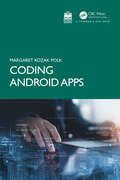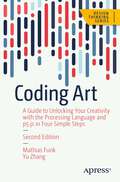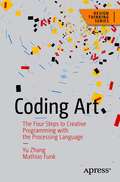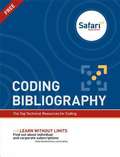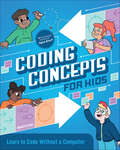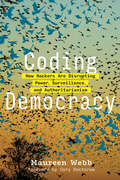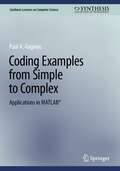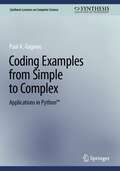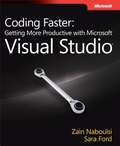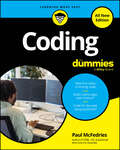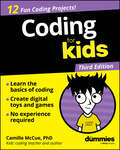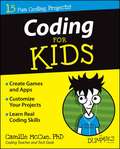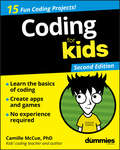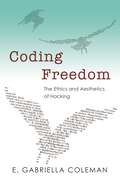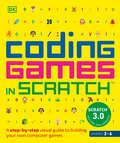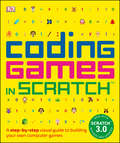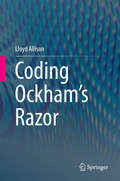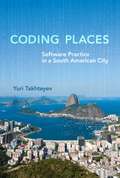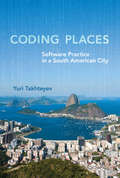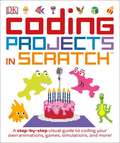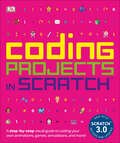- Table View
- List View
Coding Android Apps
by Margaret Kozak PolkAs Android apps continue to grow in popularity and an associated job market emerges, the ability to develop software and applications for Android smartphones will only grow more relevant in the foreseeable future. Compiled from materials used in over a decade of teaching undergraduate and graduate students majoring in computer science and information technology, this book is a hands-on, step-by-step guide to coding Android apps that have been rigorously tested.KEY FEATURES Each chapter begins with a list of student learning outcomes that can be used for assessment purposes and syllabus construction The mechanics of Android app creation is presented in a very detailed, step-by-step progression, with accompanying screenshots and code explanations New topics are introduced chapter-by-chapter in a very logical and gradational instructional manner Very detailed exercises are provided at the end of each chapter and can be used for class activities and as homework assignments. Each chapter includes multiple exercises of varying difficulty Video lessons are available as supplementary resources for each chapter to quickly illustrate in a demonstrative and visual manner the Java and XML code and Android Studio development actions covered in the chapter This book is particularly appealing for students of mobile apps development courses offered in computer science and information technology departments, as well as information systems disciplines within business schools, at both the undergraduate and graduate levels.
Coding Art: A Guide to Unlocking Your Creativity with the Processing Language and p5.js in Four Simple Steps (Design Thinking)
by Yu Zhang Mathias FunkFinally, a book on creative programming, written directly for artists and designers! This second edition offers expanded and updated content incorporating the latest advancements and trends in the field of creative programming, also for creatives who want to work directly with P5.js and online. It delves deeper into the intricacies of computational art. It includes fresh case studies that explore real-world applications of coding art, inspiring readers to think beyond traditional boundaries.Rather than following a computer science curriculum, this book is aimed at creatives who are working in the intersection of design, art, and education. Following a real-world use case of computation art, you'll see how it relates back to the four key pillars, and addresses potential pitfalls and challenges in the creative process. All code examples are presented in a fully integrated Processing example library, making it easy for readers to get started. This unique and finely balanced approach between skill acquisition and development makes Coding Art, Second Edition the ideal reference book for both creative programming and the creative process for professors and students alike.What You’ll LearnReview ideas and approaches from creative programming to different professional domainsWork with computational tools like the Processing languageUnderstand the skills needed to move from static elements to animation to interactionUse interactivity as input to bring creative concepts closer to refinement and depthSimplify and extend the design of aesthetics, rhythms, and smoothness with data structuresLeverage the diversity of art code on other platforms like the web or mobile applicationsUnderstand the end-to-end process of computation art through real world use casesStudy best practices, common pitfalls, and challenges of the creative processWho This Book Is ForThose looking to see what computation and data can do for their creative expression; learners who want to integrate computation and data into their practices in different perspectives; creative technologists, educators, digital artists and those who already know how to program, seeking creativity and inspiration in the context of computation and data.
Coding Art: The Four Steps to Creative Programming with the Processing Language (Design Thinking)
by Yu Zhang Mathias FunkFinally, a book on creative programming, written directly for artists and designers! Rather than following a computer science curriculum, this book is aimed at creatives who are working in the intersection of design, art, and education. In this book you'll learn to apply computation into the creative process by following a four-step process, and through this, land in the cross section of coding and art, with a focus on practical examples and relevant work structures. You'll follow a real-world use case of computation art and see how it relates back to the four key pillars, and addresses potential pitfalls and challenges in the creative process. All code examples are presented in a fully integrated Processing example library, making it easy for readers to get started.This unique and finely balanced approach between skill acquisition and the creative process and development makes Coding Art a functional reference book for both creative programming and the creative process for professors and students alike.What You’ll LearnReview ideas and approaches from creative programming to different professional domainsWork with computational tools like the Processing languageUnderstand the skills needed to move from static elements to animation to interactionUse interactivity as input to bring creative concepts closer to refinement and depthSimplify and extend the design of aesthetics, rhythms, and smoothness with data structuresLeverage the diversity of art code on other platforms like the web or mobile applicationsUnderstand the end-to-end process of computation art through real world use casesStudy best practices, common pitfalls, and challenges of the creative processWho This Book Is ForThose looking to see what computation and data can do for their creative expression; learners who want to integrate computation and data into their practices in different perspectives; and those who already know how to program, seeking creativity and inspiration in the context of computation and data.
Coding Bibliography
by Safari Books Online Content TeamProducing elegant code that is efficient while still being easily understood by your peers is a true art form. Making code testable and easy to maintain over time is even harder, but it can be the key to long-term productivity. Software is used in many situations to tackle incredibly complex tasks. Creating such software requires understanding many layers of responsibility and functionality. No matter if you are a novice or expert coder, there is always room for improving existing skills and developing new ones. This bibliography gives you a quick and efficient way to find the right books and videos for your coding needs in Safari Books Online.
Coding Clean, Reliable, and Safe REST APIs with ASP.NET Core 8: Develop Robust Minimal APIs with .NET 8
by Anthony GirettiLearn ASP.NET Core APIs delivered in its latest version of the Microsoft Framework: .NET 8. This book will show you how to develop APIs with ASP.NET Core 8. Author Anthony Giretti will reveal all you need to know about HTTP protocol, REST architecture style, and ASP.NET Core 8. You will learn what reflexes and mindset a developer must have to approach the development of an API of medium complexity. By performing CRUD operations on a SQL Server database, you will see how to set up a clean and reliable application with industry best practices (clean code, security, observability, optimization and testing). After completing Coding Clean, Reliable, and Safe REST APIs with ASP.NET Core 8, you will be able to develop many kinds of APIs that require a senior developer level of knowledge and provide your customers with high-quality APIs. What You Will Learn Discover the latest version of ASP.NET Core 8Code REST APIs with minimal APIsBecome familiar with clean code principlesOptimize performances with caching, background tasks and moreMake APIs resilient by handling SQL and HttpClient transient errorsUnderstand the importance of observabilityImplement Authentication and AuthorizationGrasp OWASP principlesProtect sensitive dataMaster unit testing best practices Who This Book Is For Beginner and intermediate professionals wishing to build clean, reliable and safe ASP.NET Core APIs and elevate their skills to a senior developer level.
Coding Concepts for Kids: Learn to Code Without a Computer
by Randy LynnCoding for kids without a computer—an offline skill-building book for ages 5 to 7Coding helps kids develop analytical thinking, problem-solving abilities, and beyond! In this exciting guide to coding for kids, your child will discover the core concepts of coding through colorful games and activities—without using a computer.These fun challenges can be done right inside the book or with everyday objects to help kids practice the same skills coders use, like writing clear instructions, recognizing patterns, and working efficiently. There's even a place for your beginner to invent their own codes!This coding for kids book features:Coding fundamentals—Practice algorithms, loops, conditionals, optimization, debugging, and variables with games that help kids think like a computer programmer.Meet the coder crew—Explore coding for kids with a whole cast of characters, including Al the helper, Pixel the creative expert, Lo the problem-solver, Bug the pattern-spotter, and their robot dog Spot the Bot!On and off the page—Sharpen skills with fun on-the-page puzzles and off-the-page activities that give kids a chance to practice in different ways.Set your little ones up for success with coding for kids that only requires a pencil, paper, and their imagination.
Coding Democracy: How Hackers Are Disrupting Power, Surveillance, and Authoritarianism (The\mit Press Ser.)
by Maureen WebbHackers as vital disruptors, inspiring a new wave of activism in which ordinary citizens take back democracy.Hackers have a bad reputation, as shady deployers of bots and destroyers of infrastructure. In Coding Democracy, Maureen Webb offers another view. Hackers, she argues, can be vital disruptors. Hacking is becoming a practice, an ethos, and a metaphor for a new wave of activism in which ordinary citizens are inventing new forms of distributed, decentralized democracy for a digital era. Confronted with concentrations of power, mass surveillance, and authoritarianism enabled by new technology, the hacking movement is trying to “build out” democracy into cyberspace.Webb travels to Berlin, where she visits the Chaos Communication Camp, a flagship event in the hacker world; to Silicon Valley, where she reports on the Apple-FBI case, the significance of Russian troll farms, and the hacking of tractor software by desperate farmers; to Barcelona, to meet the hacker group XNet, which has helped bring nearly 100 prominent Spanish bankers and politicians to justice for their role in the 2008 financial crisis; and to Harvard and MIT, to investigate the institutionalization of hacking. Webb describes an amazing array of hacker experiments that could dramatically change the current political economy. These ambitious hacks aim to displace such tech monoliths as Facebook and Amazon; enable worker cooperatives to kill platforms like Uber; give people control over their data; automate trust; and provide citizens a real say in governance, along with capacity to reach consensus. Coding Democracy is not just another optimistic declaration of technological utopianism; instead, it provides the tools for an urgently needed upgrade of democracy in the digital era.
Coding Examples from Simple to Complex: Applications in JavaScript™ (Synthesis Lectures on Computer Science)
by Paul A. GagniucThis book provides a comprehensive guide to JavaScript, which stands as the cornerstone of modern programming and is the main computer language driving the Internet. The author introduces readers to the rich world of JavaScript, taking them on a journey from the fundamentals to advanced topics, equipping them with the knowledge and skills needed to become a proficient science and engineering oriented JavaScript developer. The book provides a treasure trove of practical examples, meticulously crafted to deepen the reader understanding of JavaScript. This comprehensive exploration is designed to cater to novice learners as well as mature developers and scientists, equipping them with the requisite knowledge and competencies to harness the JavaScript full potential in their respective projects. This book is part of a series of works designed to present both the examples and their explanations in various computer languages, as close to a mirror version as possible.
Coding Examples from Simple to Complex: Applications in MATLAB® (Synthesis Lectures on Computer Science)
by Paul A. GagniucThis book provides a comprehensive guide to Matlab, which stands as the cornerstone of modern education and is the main computer language driving development in science and engineering. The author introduces readers to the rich world of Matlab, taking them on a journey from the fundamentals to advanced topics, equipping them with the knowledge and skills needed to become a proficient Matlab developer or scientist. The book provides a treasure trove of practical examples, meticulously crafted to deepen the reader understanding of Matlab. This comprehensive exploration is designed to cater to novice learners as well as mature developers and scientists, equipping them with the requisite knowledge and competencies to harness the Matlab full potential in their respective projects. From the basics of variable naming and program structure to complex matrix operations, recursion, and object-oriented programming, this book covers it all. This book is part of a series of worksdesigned to present both the examples and their explanations in various computer languages, as close to a mirror version as possible.
Coding Examples from Simple to Complex: Applications in Python™ (Synthesis Lectures on Computer Science)
by Paul A. GagniucThis book provides a comprehensive guide to Python, which stands as the cornerstone of modern programming and is the main computer language driving software prototyping in both industry and research. The author introduces readers to the rich world of Python, taking them on a journey from the fundamentals to advanced topics, equipping them with the knowledge and skills needed to become a proficient Python developer or scientist. The book provides a treasure trove of practical examples, meticulously crafted to deepen the reader understanding of Python. This comprehensive exploration is designed to cater to novice learners as well as mature developers and scientists, equipping them with the requisite knowledge and competencies to harness the Python full potential in their respective projects. From the basics of variable naming and program structure to complex matrix operations, recursion, and object-oriented programming, this book covers it all. This book is part of a seriesof works designed to present both the examples and their explanations in various computer languages, as close to a mirror version as possible.
Coding Faster: Getting More Productive with Microsoft® Visual Studio®
by Sara Ford Zain NaboulsiExpert advice to help you work smarter and increase your productivity with Visual Studio. Take a detailed look into Visual Studio--and learn practical techniques to help you work more efficiently. This fully revised and expanded version of Visual Studio Tips: 251 Ways to Improve Your Productivity includes a comprehensive collection of tips and shortcuts for working with the code editor, visual designers, searches, debugger, and other features in Visual Studio 2005, 2008, and 2010. You'll gain valuable insights for using this IDE--no matter what your experience level. Discover how to: Change development settings and keyboard mappings to optimize your efficiency Save time initiating a new project by creating custom templates Uncover secrets for working with the toolbox, commands, and window layouts Work with files in more practical ways, such as using the File Tab Channel Use the Editor more effectively with tips on selecting and manipulating code Apply techniques to help reduce the time you spend debugging code Create Visual Studio extensions to increase your development productivity
Coding For Dummies
by Nikhil AbrahamHands-on exercises help you learn to code like a pro No coding experience is required for Coding For Dummies,your one-stop guide to building a foundation of knowledge inwriting computer code for web, application, and softwaredevelopment. It doesn't matter if you've dabbled in coding or neverwritten a line of code, this book guides you through the basics.Using foundational web development languages like HTML, CSS, andJavaScript, it explains in plain English how coding works and whyit's needed.Online exercises developed by Codecademy, a leading online codetraining site, help hone coding skills and demonstrate results asyou practice.The site provides an environment where you can try out tutorialsbuilt into the text and see the actual output from your coding.You'll also gain access to end-of-chapter challenges to apply newlyacquired skills to a less-defined assignment. So what are youwaiting for?The current demand for workers with coding and computer scienceskills far exceeds the supplyTeaches the foundations of web development languages in aneasy-to-understand formatOffers unprecedented opportunities to practice basic codinglanguagesReaders can access online hands-on exercises and end-of-chapterassessments that develop and test their new-found skillsIf you're a student looking for an introduction to the basicconcepts of coding or a professional looking to add new skills,Coding For Dummies has you covered.
Coding For Dummies, All New Edition
by Paul McFedriesYour first step toward thinking like a coder Coding For Dummies is one of the most popular get-started guides for new coders. This all- new edition demystifies essential coding concepts before diving into building simple apps in Python and JavaScript. For anyone brand-new to writing code, this book is an ideal first step, because you'll get an overview of how coding works, the essential tools of coding, and how to apply coding in different ways. Plus, you'll get insight into how new tools like AI can quickly boost your coding know-how. Enter the world of code with this easy-to-follow Dummies guide! Learn the basics of coding, including key concepts you'll need in every coding language Get a rundown of the most popular language, and start coding in JavaScript and Python Follow step-by-step instructions to build your first apps Discover how AI can help you become a better, faster coder Looking for a foundation in the basics of coding, plus simple tasks to help you get started? Coding For Dummies is the book for you.
Coding For Kids For Dummies
by Camille McCueIt's never too early to learn how to code! Coding For Kids For Dummies helps you learn the basics of coding the fun way. This book walks you through the essentials of coding with 13 exciting projects. You'll learn what coding is, how to make digital toys and games on your computer, and how to start writing your first lines of code! With step-by-step instructions and activities, this book makes it simple to get started. And when you see error messages, don't panic! All new coders make mistakes—this book helps you figure them out and fix them, so your code will be good to go. Along the way, you'll be boosting your creativity, getting better at logical thinking, and learning a skill that will open the door to fun hobbies and careers. So get coding! Learn basic coding concepts and skills Create your own digital toys and games Figure out how to turn your ideas into code Get involved in the online coding community Kids who want to learn how to code (and the parents who want to encourage them) can get off to a great start with Coding For Kids For Dummies.
Coding For Kids For Dummies
by Camille MccueAn easy-to-grasp introduction to coding concepts for kidsCoding For Kids For Dummies breaks coding into a series of small projects, each designed to teach elementary-to-middle-school-aged students a core concept to build a game, application, or other tool. In this his hands-on, friendly guide readers will get access to a leading coding tool that has been designed specifically for kids, showing them how to create the projects provided in the book as well as how to implement them into their own creative work.Written by a teacher and leading advocate of coding education, Coding For Kids For Dummies explains to kids in plain English how to apply the math and logic skills they already have to the subject of coding. In no time, they'll be grasping basic coding concepts, completing their very own technical feats, and arming themselves with the computer science experience and know-how to prepare for a future working with technology.Lay-flat binding allows for easy access as students work on projectsFull-color, large-print design make the information more approachable to kidsKids interested in computer science get a competitive edgeThe author has dedicated her career to enhancing coding and other STEM education in schoolsIf you're a student who wants to learn coding, a parent who wants to help your kid pursue an interest in coding, or a teacher who is in need of a supplemental course book for your computer science class, Coding For Kids For Dummies has you covered.
Coding For Kids For Dummies (For Kids For Dummies)
by Camille McCue Ph.DA guide for kids who want to learn coding Coding is quickly becoming an essential academic skill, right up there with reading, writing, and arithmetic. This book is an ideal way for young learners ages 8-13 who want more coding knowledge than you can learn in an hour, a day, or a week. Written by a classroom instructor with over a decade of experience teaching technology skills to kids as young as five, this book teaches the steps and logic needed to write code, solve problems, and create fun games and animations using projects based in Scratch and JavaScript. This 2nd Edition is fully updated to no longer require any limited-time software downloads to complete the projects. Learn the unique logic behind writing computer code Use simple coding tools ideal for teaching kids and beginners Build games and animations you can show off to friends Add motion and interactivity to your projects Whether you’re a kid ready to make fun things using technology or a parent, teacher, or mentor looking to introduce coding in an eager child’s life, this fun book makes getting started with coding fun and easy!
Coding Freedom: The Ethics and Aesthetics of Hacking
by E. Gabriella ColemanWho are computer hackers? What is free software? And what does the emergence of a community dedicated to the production of free and open source software--and to hacking as a technical, aesthetic, and moral project--reveal about the values of contemporary liberalism? Exploring the rise and political significance of the free and open source software (F/OSS) movement in the United States and Europe, Coding Freedom details the ethics behind hackers' devotion to F/OSS, the social codes that guide its production, and the political struggles through which hackers question the scope and direction of copyright and patent law. In telling the story of the F/OSS movement, the book unfolds a broader narrative involving computing, the politics of access, and intellectual property. E. Gabriella Coleman tracks the ways in which hackers collaborate and examines passionate manifestos, hacker humor, free software project governance, and festive hacker conferences. Looking at the ways that hackers sustain their productive freedom, Coleman shows that these activists, driven by a commitment to their work, reformulate key ideals including free speech, transparency, and meritocracy, and refuse restrictive intellectual protections. Coleman demonstrates how hacking, so often marginalized or misunderstood, sheds light on the continuing relevance of liberalism in online collaboration.
Coding Games in Scratch
by Carol VordermanIf you like playing computer games, why not make your own? This book has all you need to build amazing games, including thrilling racing challenges, zany platform games, and fiendish puzzles.Follow the simple steps to become an expert coder, using the popular programming language Scratch™ 3.0. This updated edition is the first to be tablet-computer friendly, making it even easier to get coding.Improve your coding skills and create your own games, before remixing and customizing them. Jumpy Monkey will show you how to simulate gravity in your games, or give Dog's Dinner a try to learn about collision detection.Pick up the fundamentals of computer programming in steps that make even the most difficult coding concepts fun and easy to understand. Don't just learn how computer code works—understand why it's done that way.Then share your games online and challenge friends and family to beat each other's scores. Once you've whizzed through the book, the possibilities are endless!
Coding Games in Scratch: A Step-by-Step Visual Guide to Building Your Own Computer Games (DK Help Your Kids)
by Jon WoodcockScratch 3.0 has landed! Stay ahead of the curve with this fully updated guide for beginner coders.Coding is not only a highly sought-after skill in our digital world, but it also teaches kids valuable skills for life after school. This book teaches important strategies for solving problems, designing projects, and communicating ideas, all while creating games to play with their friends.Children will enjoy the step-by-step visual approach that makes even the most difficult coding concepts easy to master. They will discover the fundamentals of computer programming and learn to code through a blend of coding theory and the practical task of building computer games themselves. The reason coding theory is taught through practical tasks is so that young programmers don't just learn how computer code works - they learn why it's done that way. With Coding Games in Scratch, kids can build single and multiplayer platform games, create puzzles and memory games, race through mazes, add animation, and more. It also supports STEM education initiatives and the maker movement.Follow Simple Steps – Improve Your Skills – Share Your Games!If you like playing computer games, why not create your own? Essential coding concepts are explained using eight build-along game projects. Coding Games In Scratch guides young coders step-by-step, using visual samples, easy-to-follow instructions, and fun pixel art. This coding book for kids has everything you need to build amazing Scratch 3.0 games, including thrilling racing challenges, zany platform games, and fiendish puzzles. Follow the simple steps to become an expert coder using the latest version of the popular programming language Scratch 3.0 in this new edition. Improve your coding skills and create your own games before remixing and customizing them. Share your games online and challenge friends and family to beat each other's scores! In this book, you will: - Learn about setting the scene, what makes a good game and playability- Discover objects, rules, and goals- Explore hacks and tweaks, camera angles, fine-tuning and controls- And much moreComputer coding teaches kids how to think creatively, work collaboratively, and reason systematically, and is quickly becoming a necessary and sought-after skill. DK's computer coding books for kids are full of fun exercises with step-by-step guidance, making them the perfect introductory tools for building vital skills in computer programming. Add Coding Projects in Scratch and Coding Projects in Python to your collection.
Coding Literacy: How Computer Programming Is Changing Writing (Software Studies)
by Annette VeeHow the theoretical tools of literacy help us understand programming in its historical, social and conceptual contexts.The message from educators, the tech community, and even politicians is clear: everyone should learn to code. To emphasize the universality and importance of computer programming, promoters of coding for everyone often invoke the concept of “literacy,” drawing parallels between reading and writing code and reading and writing text. In this book, Annette Vee examines the coding-as-literacy analogy and argues that it can be an apt rhetorical frame. The theoretical tools of literacy help us understand programming beyond a technical level, and in its historical, social, and conceptual contexts. Viewing programming from the perspective of literacy and literacy from the perspective of programming, she argues, shifts our understandings of both. Computer programming becomes part of an array of communication skills important in everyday life, and literacy, augmented by programming, becomes more capacious.Vee examines the ways that programming is linked with literacy in coding literacy campaigns, considering the ideologies that accompany this coupling, and she looks at how both writing and programming encode and distribute information. She explores historical parallels between writing and programming, using the evolution of mass textual literacy to shed light on the trajectory of code from military and government infrastructure to large-scale businesses to personal use. Writing and coding were institutionalized, domesticated, and then established as a basis for literacy. Just as societies demonstrated a “literate mentality” regardless of the literate status of individuals, Vee argues, a “computational mentality” is now emerging even though coding is still a specialized skill.
Coding Ockham's Razor
by Lloyd AllisonThis book explores inductive inference using the minimum message length (MML) principle, a Bayesian method which is a realisation of Ockham's Razor based on information theory. Accompanied by a library of software, the book can assist an applications programmer, student or researcher in the fields of data analysis and machine learning to write computer programs based upon this principle. MML inference has been around for 50 years and yet only one highly technical book has been written about the subject. The majority of research in the field has been backed by specialised one-off programs but this book includes a library of general MML–based software, in Java. The Java source code is available under the GNU GPL open-source license. The software library is documented using Javadoc which produces extensive cross referenced HTML manual pages. Every probability distribution and statistical model that is described in the book is implemented and documented in the software library. The library may contain a component that directly solves a reader's inference problem, or contain components that can be put together to solve the problem, or provide a standard interface under which a new component can be written to solve the problem. This book will be of interest to application developers in the fields of machine learning and statistics as well as academics, postdocs, programmers and data scientists. It could also be used by third year or fourth year undergraduate or postgraduate students.
Coding Places
by Yuri TakhteyevSoftware development would seem to be a quintessential example of today's Internet-enabled "knowledge work"--a global profession not bound by the constraints of geography. In Coding Places, Yuri Takhteyev looks at the work of software developers who inhabit two contexts: a geographical area--in this case, greater Rio de Janeiro--and a "world of practice," a global system of activities linked by shared meanings and joint practice. The work of the Brazilian developers, Takhteyev discovers, reveals a paradox of the world of software: it is both diffuse and sharply centralized. The world of software revolves around a handful of places--in particular, the San Francisco Bay area--that exercise substantial control over both the material and cultural elements of software production. Takhteyev shows how in this context Brazilian software developers work to find their place in the world of software and to bring its benefits to their city. Takhteyev's study closely examines Lua, an open source programming language developed in Rio but used in such internationally popular products as World of Warcraft and Angry Birds. He shows that Lua had to be separated from its local origins on the periphery in order to achieve success abroad. The developers, Portuguese speakers, used English in much of their work on Lua. By bringing to light the work that peripheral practitioners must do to give software its seeming universality, Takhteyev offers a revealing perspective on the not-so-flat world of globalization.
Coding Places: Software Practice in a South American City (Acting with Technology)
by Yuri TakhteyevAn examination of software practice in Brazil that reveals both the globalization and the localization of software development.Software development would seem to be a quintessential example of today's Internet-enabled “knowledge work”—a global profession not bound by the constraints of geography. In Coding Places, Yuri Takhteyev looks at the work of software developers who inhabit two contexts: a geographical area—in this case, greater Rio de Janeiro—and a “world of practice,” a global system of activities linked by shared meanings and joint practice. The work of the Brazilian developers, Takhteyev discovers, reveals a paradox of the world of software: it is both diffuse and sharply centralized. The world of software revolves around a handful of places—in particular, the San Francisco Bay area—that exercise substantial control over both the material and cultural elements of software production. Takhteyev shows how in this context Brazilian software developers work to find their place in the world of software and to bring its benefits to their city.Takhteyev's study closely examines Lua, an open source programming language developed in Rio but used in such internationally popular products as World of Warcraft and Angry Birds. He shows that Lua had to be separated from its local origins on the periphery in order to achieve success abroad. The developers, Portuguese speakers, used English in much of their work on Lua. By bringing to light the work that peripheral practitioners must do to give software its seeming universality, Takhteyev offers a revealing perspective on the not-so-flat world of globalization.
Coding Projects In Scratch
by Dorling Kindersley Publishing Staff Jon WoodcockA straightforward, visual guide that shows young learners how to build their own computer projects using Scratch, a popular free programming language, using fun graphics and easy-to-follow instructions. <p><p> Kids can animate their favorite characters, build games to play with friends, create silly sound effects, and more with Coding Projects in Scratch. All they need is a desktop or laptop with Adobe 10.2 or later, and an internet connection to download Scratch 2.0. Coding can be done without download on https://scratch.mit.edu. <p> Step-by-step instructions teach essential coding basics and outline 18 fun and exciting projects, including a personalized birthday card; a "tunnel of doom" multiplayer game; a dinosaur dance party animation with flashing lights, music, and dance moves--and much more. <p> The simple, logical steps in Coding Projects in Scratch are fully illustrated with fun pixel art and build on the basics of coding, so that kids can have the skills to make whatever kind of project they can dream up. <p> Supporting STEM education initiatives, computer coding teaches kids how to think creatively, work collaboratively, and reason systematically, and is quickly becoming a necessary and sought-after skill. DK's computer coding books are full of fun exercises with step-by-step guidance, making them the perfect introductory tools for building vital skills in computer programming.
Coding Projects in Scratch: A Step-by-Step Visual Guide to Coding Your Own Animations, Games, Simulations, a (DK Help Your Kids)
by Jon WoodcockA perfect introduction to coding for young minds! This updated step-by-step visual guide teaches children to create their own projects using Scratch 3.0.Suitable for complete beginners, this educational book for kids gives readers a solid understanding of programming. Teach them to create their own projects from scratch, preparing them for more complex programming languages like Python.Techy kids will familiarize themselves with Scratch 3.0 using this beginner's guide to scratch coding. Difficult coding concepts become fun and easy to understand, as budding programmers build their own projects using the latest release of the world's most popular programming language for beginners.Make a Dino Dance Party or create your own electronic birthday cards for friends and family. Build games, simulations, and mind-bending graphics as you discover the awesome things computer programmers can do with Scratch 3.0. This second edition of Coding Projects in Scratch uses a visual step-by-step approach to split complicated code into manageable, easy-to-digest chunks. Even the most impressive projects become possible. This book is an impressive guide that is perfect for anyone who wants to learn to code. Follow Simple Steps, Improve Your Skills & Share Your Creations!Follow the simple steps to become an expert coder using the latest version of the popular programming language Scratch 3.0 in this new edition. Create mind-bending illusions, crazy animations, and interactive artwork with this amazing collection of Scratch projects. Suitable for beginners and experts alike, this fabulous introduction to programming for kids has everything you need to learn how to code. You'll improve your coding skills and learn to create and customize your own projects, then you can share your games online and challenge friends and family to beat each other's scores! What's inside this kids' coding book? - Simulations, mind-benders, music, and sounds- Algorithms, virtual snow, and interactive features- Different devices, operating systems, programming languages and moreComputer coding teaches kids how to think creatively, work collaboratively, and reason systematically, and is quickly becoming a necessary and sought-after skill. DK's computer coding books for kids are full of fun exercises with step-by-step guidance, making them the perfect introductory tools for building vital skills in computer programming. Coding Projects in Scratch is one of three brilliant coding books for kids. Add Coding Games in Scratch and Coding Projects in Python to your collection.
